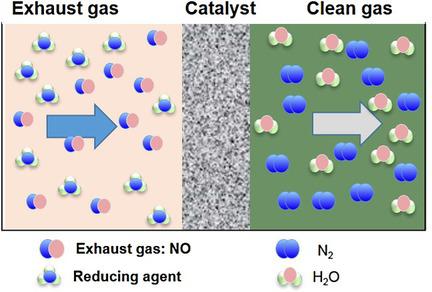当前位置:
X-MOL 学术
›
ChemCatChem
›
论文详情
Our official English website, www.x-mol.net, welcomes your feedback! (Note: you will need to create a separate account there.)
Conventional and New Materials for Selective Catalytic Reduction (SCR) of NOx
ChemCatChem ( IF 4.5 ) Pub Date : 2018-02-14 , DOI: 10.1002/cctc.201701414 Yu Liu 1 , Jun Zhao 1 , Jong-Min Lee 1
ChemCatChem ( IF 4.5 ) Pub Date : 2018-02-14 , DOI: 10.1002/cctc.201701414 Yu Liu 1 , Jun Zhao 1 , Jong-Min Lee 1
Affiliation

|
It is important and necessary to minimize NOx pollutant released into the atmosphere owing to the harmful environmental and health effects brought by NOx emission. Many techniques are available to reduce NOx emission, among of them, Selective Catalytic Reduction (SCR) is considered as one of the most efficient techniques. Conventional SCR systems involve ammonia (NH3) or urea (CO(NH2)2) as a reducing reagent to reduce NOx to N2 and H2O at high temperatures 300–400 °C. Research on developing novel low‐temperature catalysts (LTC) for SCR of NOx still remains of interest. This work reviewed and compared conventional SCR catalysts with newly emerging Metal‐Organic‐Frame (MOFs) materials as potential alternatives for SCR catalysts.
中文翻译:

用于NOx选择性催化还原(SCR)的常规材料和新材料
这是重要和必要的,以尽量减少NO X污染物释放到由于由NO所带来的有害环境和健康影响的大气X排放。许多技术可减少NO X排放,他们之中,选择性催化还原(SCR)被认为是最有效的技术之一。常规SCR系统包括氨(NH 3)或尿素(CO(NH 2)2),以降低还原试剂NO X为N 2和H 2 O不连到高温300-400℃。开发用于NO x SCR的新型低温催化剂(LTC)的研究仍然值得关注。这项工作对常规SCR催化剂与新兴的金属有机框架(MOF)材料进行了比较,并将其作为SCR催化剂的潜在替代品。
更新日期:2018-02-14
中文翻译:

用于NOx选择性催化还原(SCR)的常规材料和新材料
这是重要和必要的,以尽量减少NO X污染物释放到由于由NO所带来的有害环境和健康影响的大气X排放。许多技术可减少NO X排放,他们之中,选择性催化还原(SCR)被认为是最有效的技术之一。常规SCR系统包括氨(NH 3)或尿素(CO(NH 2)2),以降低还原试剂NO X为N 2和H 2 O不连到高温300-400℃。开发用于NO x SCR的新型低温催化剂(LTC)的研究仍然值得关注。这项工作对常规SCR催化剂与新兴的金属有机框架(MOF)材料进行了比较,并将其作为SCR催化剂的潜在替代品。



























 京公网安备 11010802027423号
京公网安备 11010802027423号